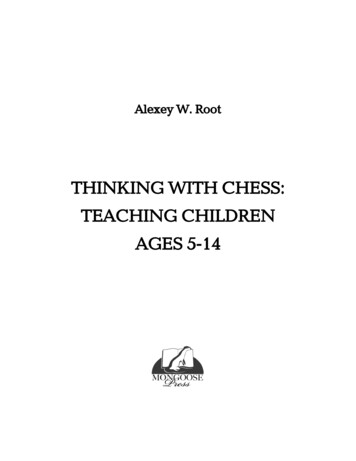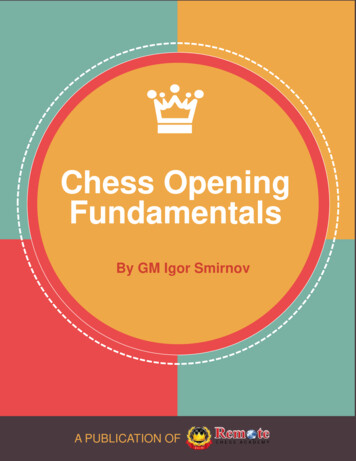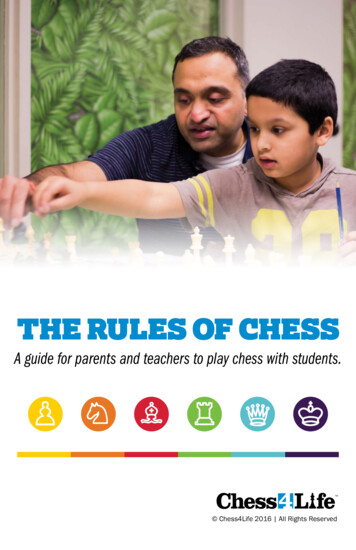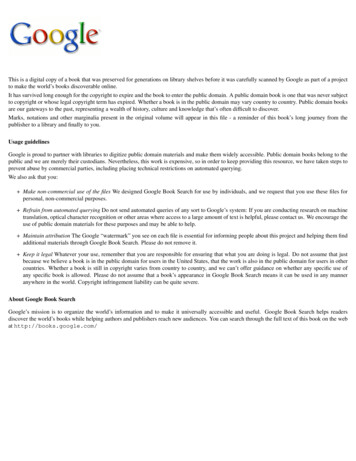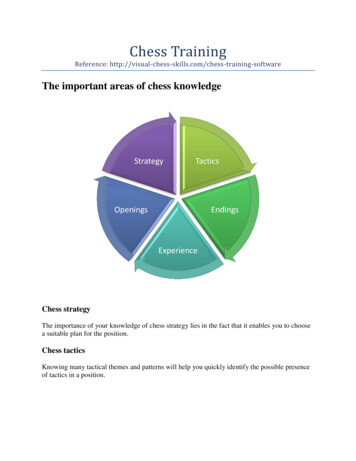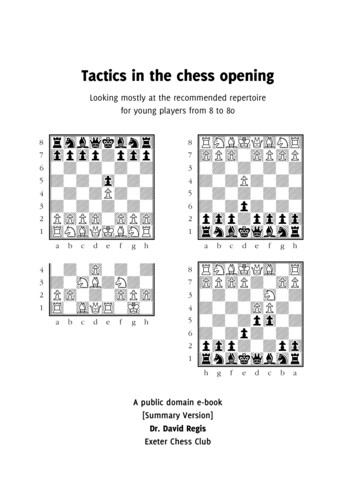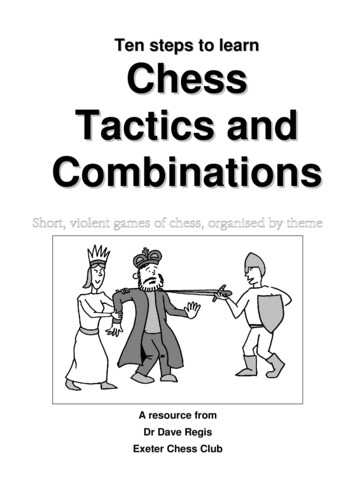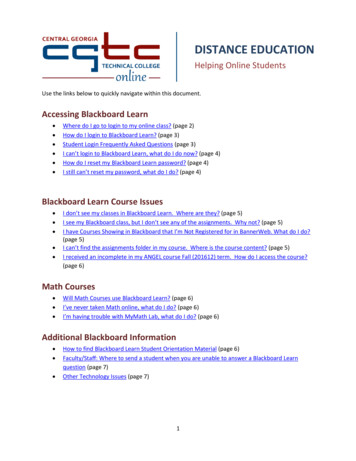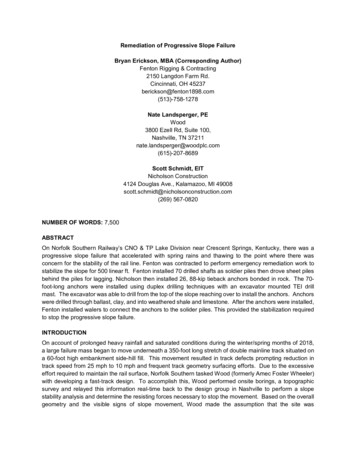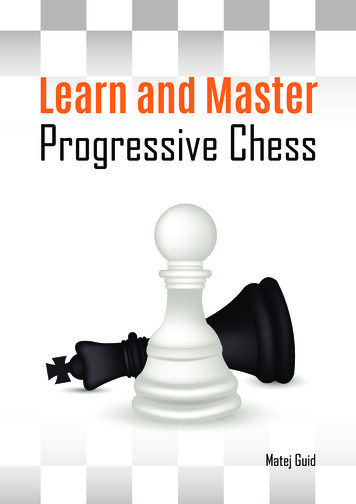
Transcription
Learn and MasterProgressive ChessMatej Guid
The CIP record was created by the National and University Library Ljubljana.COBISS.SI-ID 293222144ISBN 978-961-6209-96-0 (pdf)The electronic edition of this book is available at URL: t 2017 Založba UL FRI. All rights reserved.Reviewers: prof. dr. Ivan Bratko, prof. dr. H. Jaap van den HerikProofreading: prof. dr. Walter A. KostersPublisher: Založba UL FRI, LjubljanaUniversity of Ljubljana, Faculty of Computer and Information ScienceFirst edition, 2017Design of book cover: Bojana FortunaIllustrations: prof. dr. Matej Guid with DeepArt.ioEditor: prof. dr. Franc Solina
PrefaceProgressive chess is an incredibly exciting game. This chess variant was particularly popular amongItalian players in the last two decades of the previous century, but seems to be almost forgotten atthe time of this writing. The aim of this book is to provide training materials that will enableinterested readers to learn and master the game progressive chess.The author assumes basic knowledge of the game of chess. From the perspective of education,mastering progressive chess may lead to improved imagination and calculation skills. The game ofprogressive chess may also provide a challenging domain for chess composers.The preparation of the training materials used in this book would be hardly possible without theexcellent computer program Progressive Chess created at the University of Ljubljana. The programis freely available online and is presented in detail in the following publication:Vito Janko and Matej Guid. "A Program for Progressive Chess." Theoretical Computer Science 644 (2016): 76-91.The program was developed by Vito Janko as a part of his master’s degree thesis at the Faculty ofComputer and Information Science, for which he also received the faculty’s award for students.Developing a computer program for progressive chess is a very difficult task. The extremely largebranching factor due to the combinatorial explosion of possibilities produced by having severalmoves per turn makes progressive chess a very rich environment for testing new algorithms andideas. In particular, an efficient search for checkmates in progressive chess is a very interestingchallenge and may be both fun and an insightful part of any course on artificial intelligence.By developing a strong computer program and training materials, we hope to revive the interest inprogressive chess among chess players. By the book and the computer program, the chess playersmay obtain a strong playing partner and an adequate analysis tool. Moreover, they will possesslearning materials that will enable them to confront both the computer program and otherprogressive chess players all over the world.We hope that you will find this book useful on your own way to become a master of progressivechess and have as much fun playing this game as we did in creating this book for you.Matej GuidLjubljana, Slovenia2017
ForewordIn my late teens I was an avid chess enthusiast, playing on board one for a tiny club in Hamburg,Germany. I did fairly well, considering I knew very little openings theory – that aspect of the gamewas too tedious for my taste. I relied completely on tactical skills, and that was not enough to bringme to full master level. So I started experimenting with chess variants and chess problems.I solved countless mates in 2, 3 and more moves, and fell in love with the compositions of SamLoyd. Then I turned to helpmates, which are problems in which Black helps White to mate him ina specified number of moves. That genre shows you the breath-taking range of mates that arepossible in chess but will never occur in regular tournament play. From there I progressed to serieshelpmates, a problem form in which Black plays a specified number of consecutive moves, all ofwhich must be legal, after which White can deliver mate in one move. It was a bit outlandish, eventhough there were many beautiful and wondrous examples.But of course over-the-board chess, a contest between two humans, has a primeval attraction,and I continued playing. To overcome my weakness in openings knowledge I dabbled in chessvariants, of which there are hundreds. For a while I played Checkless Chess, quite intensely. Thisvariant is completely defined by one simple rule: checks are illegal unless they deliver mate.Suddenly the king becomes a powerful attacking piece, a kamikaze warrior living dangerously torestrict the enemy’s forces. I spent some months playing this game quite intensely.And then I discovered Scottish Chess, so named I believe because it was first played in Scotland inthe late 1930s. Actually that is not well-established fact, but at least England appears to be themost likely country of origin. Which is not of crucial importance, since the game soon becameuniversally known as Progressive Chess, when it became popular as high-level tournaments werebeing staged. Soon it was – and is to this day – one of the most widely practised of all chessvariants. Hundreds of tournaments have been staged over the years, and there is database ofgames, PRBASE, with more than ten thousand master-level games. Italy was the dominant countrywhere Progressive Chess was played, during a period when the Soviet Union dominated classicalchess, and the great champions in the history of Progressive Chess all bear Italian names likeLeoncini, Magari, Dipilato, Polacco and Cassano – corresponding to Alekhine, Botvinnik, Petrosian,Spassky, Karpov and Kasparov in classical chess.In Progressive Chess White starts with a single move, Black replies with two consecutive moves,White has three consecutive moves, and so on. Checks are only allowed on the final move, so thatthe opponent’s king can get out of it. Checking the opponent’s king in the middle of a sequencemeans it ends there and it becomes the turn of the other side again, and of course no player mayexpose his own king to check at any time during his turn. These two very logical rules give thegame a special flavour, and especially Progressive Chess problems and studies becomewonderfully challenging because of them.
After an initial period of disinclination I became a dedicated Progressive Chess fan, and soon afairly competent player, actually winning a lot of games, because (a) nobody else had studied itsystematically and my lack of openings knowledge was not an issue; and (b) my experience withhelpmates and series helpmates was a big advantage. Progressive Chess was very attractivebecause the action started much sooner than in classical chess, where there is usually a fairly longphase when very little happens – you are basically making sure you don’t lose material and aretrying to manoeuver your pieces onto good squares. Even in the middle and endgame there arelong phases which can be fairly tedious. In Progressive Chess, on the other hand, the action comesafter just a few moves – usually on turn five or six you sit there calculating very deep and complextactics, lines that could lead to mate or a game-deciding advantage, with the danger that you mightbe overlooking a reply, one move longer, that could lead to your own demise. You soon learn thatgiving check on the last move of a sequence is a good strategy, as it restricts the opponent togetting out of check on his first move. And already on White’s third and fourth turns you arelooking at the promotion of pawns that have not yet moved. And as in Checkless Chess the kingbecomes a powerful attacking piece when it advances into enemy lines. There it can sorely restrictthe opponent’s ability to capture or to advance pawns because those moves lead to prematurechecks. The endgame has its own strategic rules. For instance king and rook vs king is almost alwaysa draw, whereas king and two knights vs the bare king (prepare for this) is a win for Black, but notfor White! The reason is that Black always has an even number of moves on his turn, while White’sodd-number oscillations with a bare king make him vulnerable to a checkmate with two knights.There are many such strategical points that have to be learned if you want to become a master.I played Progressive Chess intermittently for maybe a year, but it was difficult to find opponents.There were a lot of tournaments, but few (actually none) in my area of residence. And so after awhile my over-the-board activities in this attractive field of chess ran dry. Luckily I discovered thatit is not absolutely necessary to have an opponent sitting across from you to enjoy the variant.There is a whole world of Progressive Chess problems, positions with very clever and very deepsolutions, in many cases equal in beauty to my beloved helpmates. And so I continued to delveinto this field, solving mates and studies, but very rarely actually playing a game.Then I learned, quite recently, that a friend, Professor Matej Guid of the University of Ljubljana,had actually written a book on subject, a comprehensive volume with all the information you needto get started (or become an expert). I read it voraciously and spent pleasant hours solving someof the hundreds of problems and studies that he has included. I have also learned that a graduatestudent at the University of Ljubljana, Vito Janko, has developed a Progress Chess playing programthat gives you a strong opponent or training partner, as well as an analytical tool to study gamesand problems. As chance would have it, part three of this book gives you basic lessons in openingsand endgames, just as any normal chess primer helps you get started in the classical version.I strongly advocate that you peruse this e-book, the first comprehensive work in a non-Italianlanguage; and get the Progressive Chess engine of Vito Janko, which is also available as a mobileapp. Then you can give this fascinating chess variant a try. Chances are you will not regret it.Frederic FriedelEditor-in-chief at ChessBase.com and co-founder of ChessBase
Part 1: IntroductionProgressive chess8Strategy14Part 2: Training materialsProgressive checkmates18Checkmate in 419Checkmate in 523Checkmate in 628Checkmate in 734Checkmate in 840Checkmate in 946The Italian checkmate50Winning sequences56Drawing sequences61Solutions to exercises66Part 3: Theory and practiceOpening variations74Endgame theory77Online resources816
7
In progressive chess, players play progressively longer series of moves. White starts from the initialchess position with playing one move, Black then makes two consecutive moves, White replieswith three moves, Black then plays four moves, and so on. We will call a sequence of moves a turn.The standard rules for chess apply, with the following six exceptions: Players alternately make a sequence of moves of increasing number. A check can be given only on the last move of a turn. A player may not expose his1 own king to check at any time during his turn. A king in check must get out of check with the first move of the sequence. A player who runs out of legal moves during his turn is stalemated and the game is drawn. En passant capture is admissible on the first move of a turn only.Below we show a short game in order to understand better what progressive chess really is.GAME 11.e42.d5f6White already threatened a checkmate at the square f7, using the bishop and the queen. The moved7-d5 prevents this idea, and the knight was developed to f6 in the same turn.8
3.exd5f3b5 White has taken a pawn and developed two pieces. Also, giving a check at the end of the sequencewhich limits Black’s options. All of these seems reasonable, what do you think?d74.xb5e2xd1Black responded to the check on the first move of the sequence, and then captured two dangerousopponent’s pieces: the bishop and the queen. However, this was a decisive mistake.5.e5 g4 g5 g6 gxf7#1-0Checkmate!1For brevity, we use 'he' and 'his' whenever 'he or she' and 'his or her' are meant.9
The black king is now in check and has no place to go, since the pawn at f7 is firmly defended bythe knight. White wins the game.ANALYSIS OF GAME 1The question is: did Black play well on the 4th turn? Well, it turns out that he had a much bettersequence at his disposal.4.c6 Qb6e4 Qf2#In this case Black would have won the game by giving a checkmate with his queen.So, where did White go wrong? Well, certainly on the 3rd turn. A much better response to Black’searly opening moves would be the following sequence.b5 3.e5 d4This would lead to a position in which White has the better chances.10
GAME 2Let us take a look at a second game, which is a slightly more advanced game.1.e42.d5c63.e5 d4b5In this position, Black has four moves at his disposal. Black’s priority is to remove the white queenfrom the board. It happened as follows.4.g4xd1d7 Qb8With this sequence, Black has improved the position of his king and moved the queen to asquare that is more difficult to reach by any white pieces. But, see what happened.5.a3c4a511xc6xb8
White captured the opponent’s queen and knight by also giving a double check to the king, forcingit to lose precious time.6.e6xb8 a6 axb5d7 c5Black has captured two white pieces, secured the king again, and advanced with two of thepawns, bringing them closer to the square of promotion. Now it is White’s turn.7.a4 axb5h6xg7xh8d2xd1White achieved the following: one of the dangerous black pawns and the black bishop on d1 werecaptured, also a rook has been removed from the board, and the position of the white king wasslightly improved. White is currently a rook and two pawns up, which is also not bad.12
However, White’s sequence was in fact the decisive mistake! Black now has checkmate in eightmoves at his disposal. Can you see the winning sequence?8.cxd4c8 d3 d4 dxc2 c1e6b4#0-1The final position deserves a diagram.Black excellently coordinated the pieces, including a rather surprising promotion into a knight, inorder to deliver checkmate in time. Fascinating play by Black!In fact, this was a blitz
mastering progressive chess may lead to improved imagination and calculation skills. The game of progressive chess may also provide a challenging domain for chess composers. The preparation of the training materials used in this book would be hardly possible without the excellent computer program Progressive Chess created at the University of Ljubljana. The program is freely available online .
